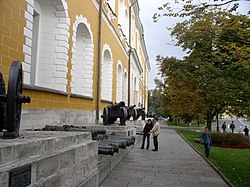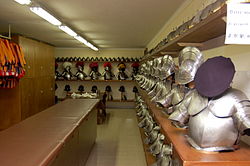This article needs additional citations for verification .(September 2014) |





An arsenal is a place where arms and ammunition are made, maintained and repaired, stored, or issued, in any combination, whether privately or publicly owned. Arsenal and armoury (British English) or armory (American English) [1] [2] are mostly regarded as synonyms, although subtle differences in usage exist.
Contents
A sub-armory is a place of temporary storage or carrying of weapons and ammunition, such as any temporary post or patrol vehicle that is only operational in certain times of the day. [3]